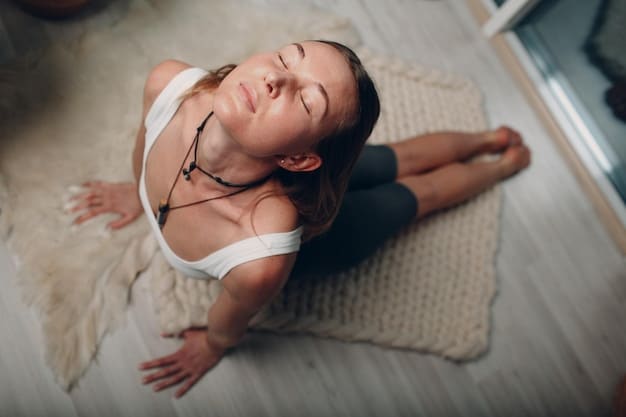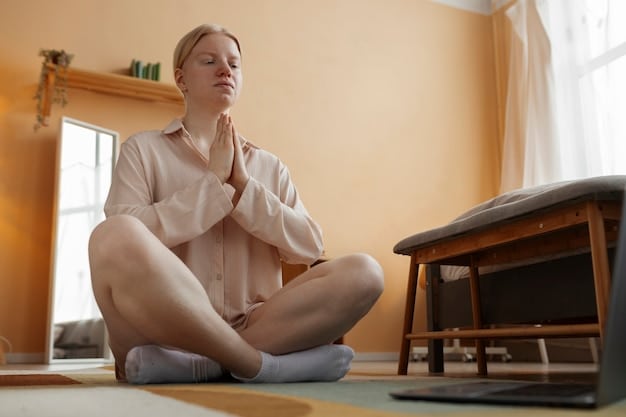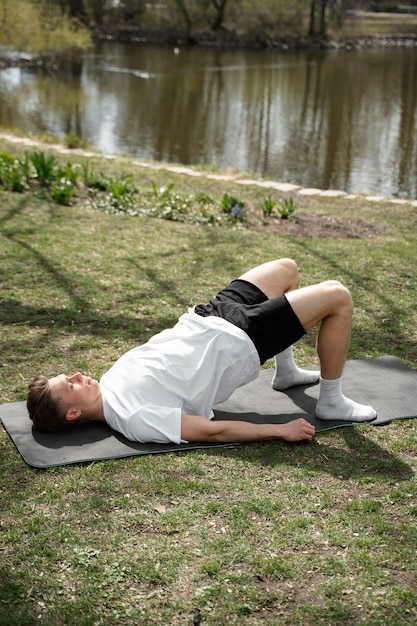Progressive Muscle Relaxation (PMR): Your 20-Minute Guide to Stress Relief

Progressive Muscle Relaxation (PMR) is a relaxation technique where you tense and release different muscle groups in a specific order, allowing you to reduce tension and promote relaxation in about 20 minutes.
Feeling overwhelmed and stressed? Discover Progressive Muscle Relaxation (PMR): A Step-by-Step Guide to Reducing Tension and Promoting Relaxation in 20 Minutes, a simple yet effective technique to melt away tension and find inner peace.
Understanding Progressive Muscle Relaxation (PMR)
Progressive Muscle Relaxation (PMR) is a technique developed by Dr. Edmund Jacobson in the 1920s. It’s rooted in the observation that physical tension often accompanies mental and emotional stress. By systematically tensing and relaxing different muscle groups, PMR aims to reduce overall tension and promote a state of relaxation.
Unlike some other relaxation methods that require specialized training, PMR is relatively easy to learn and practice. It involves a sequence of tensing a specific muscle group, holding the tension briefly, and then releasing it, focusing on the difference between tension and relaxation. This process helps to increase awareness of bodily sensations and allows individuals to consciously release accumulated stress.
The Science Behind PMR
The effectiveness of PMR isn’t just anecdotal; it’s supported by scientific research. Studies have shown that PMR can reduce levels of cortisol, the stress hormone, and activate the parasympathetic nervous system, which is responsible for the body’s “rest and digest” response. This activation leads to decreased heart rate, lower blood pressure, and a general feeling of calm.
Furthermore, PMR can improve sleep quality by reducing muscle tension and calming the mind before bed. It’s also a valuable tool for managing chronic pain conditions, as it helps to break the cycle of pain and tension.
Benefits of Practicing PMR
The benefits of incorporating PMR into your routine are numerous and far-reaching. Beyond its immediate relaxation effects, PMR can lead to long-term improvements in overall well-being.
- Reduced stress and anxiety levels
- Improved sleep quality and reduced insomnia
- Lower blood pressure and heart rate
- Relief from chronic pain conditions
- Increased body awareness
In conclusion, Progressive Muscle Relaxation is a scientifically backed and effective technique for reducing stress and promoting relaxation. Its ease of learning and wide range of benefits make it a valuable tool for anyone seeking to improve their mental and physical well-being.
Preparing for Your PMR Session
Before diving into the practice of Progressive Muscle Relaxation, setting the stage for a successful session is crucial. A little preparation will make your PMR experience much more effective and enjoyable.
Creating the right environment and having the right mindset can significantly enhance the benefits of the technique. This includes choosing a comfortable and quiet space, dressing comfortably, and focusing on your intention for relaxation.
Finding a Quiet and Comfortable Space
The first step in preparing for PMR is to find a quiet and comfortable space. This should be a place where you can lie down or sit comfortably without being disturbed. Ideally, the space should be free from distractions such as loud noises, bright lights, or interruptions from other people.
Consider dimming the lights or using a sleep mask to block out any remaining light. You might also want to adjust the temperature to ensure that you’re neither too hot nor too cold.
Comfortable Clothing and Posture
What you wear during your PMR session can also impact your ability to relax. Opt for loose, comfortable clothing that doesn’t restrict your movement or put pressure on any part of your body. Avoid wearing tight belts, collars, or anything else that might feel constricting.
As for posture, you can either lie down on your back with your arms at your sides or sit comfortably in a chair with your feet flat on the floor. The key is to find a position that allows you to fully relax your muscles without straining any part of your body.

Setting Your Intention
Before you begin the PMR sequence, take a moment to set your intention for the session. This involves focusing your mind on what you hope to achieve through the practice. For example, you might set an intention to reduce stress, improve sleep, or simply cultivate a sense of inner peace.
You can also use this time to visualize yourself feeling relaxed and at ease. This can help to prime your mind and body for the relaxation that is to come.
In summary, by carefully preparing your environment, clothing, and mindset, you can maximize the benefits of your Progressive Muscle Relaxation session and create a truly transformative experience.
The Step-by-Step PMR Technique (20 Minutes)
Now that you’re prepared, let’s dive into the actual steps of Progressive Muscle Relaxation. This is a systematic approach that involves tensing and releasing specific muscle groups in a particular order. The entire sequence can typically be completed in about 20 minutes.
Each muscle group will be tensed for about 5-10 seconds, followed by a 20-30 second release period. During the release, focus on the sensation of relaxation and the difference between tension and ease.
Muscle Groups and Sequence
The standard PMR sequence typically includes the following muscle groups, performed in the order listed below:
- Hands: Make a tight fist
- Arms: Bend your elbows and tense your biceps.
- Shoulders: Shrug your shoulders upward toward your ears.
- Forehead: Raise your eyebrows as high as you can.
- Eyes and Nose: Close your eyes tightly and wrinkle your nose.
- Jaw: Clench your teeth
- Neck: Press your head backward into the surface you’re on.
- Chest: Take a deep breath and hold it.
- Stomach: Tighten your stomach muscles.
- Buttocks: Squeeze your buttock muscles together.
- Thighs: Tense your thigh muscles.
- Lower Legs: Point your toes downward and tense your calf muscles.
- Feet: Curl your toes inward.
Tips for Effective Tensing and Releasing
To get the most out of each contraction, focus on isolating the specific muscle group you’re working on. Avoid tensing other muscles unnecessarily. As you tense, notice the sensation of tightness and pressure in the muscle.
When it’s time to release, let go completely and focus on the feeling of relaxation and ease. Notice how the tension melts away, leaving your muscles feeling softer and looser.
Breathing and Mental Focus
Throughout the PMR sequence, pay attention to your breathing. Breathe deeply and slowly, inhaling as you tense and exhaling as you release. This will help to deepen your relaxation and calm your mind.
If your mind wanders, gently bring your attention back to the sensation of tension and relaxation in your muscles. Avoid judging yourself for having distracting thoughts; simply acknowledge them and let them go.
In conclusion, by following the step-by-step PMR technique, paying attention to your body, and focusing on your breath, you can effectively reduce tension and promote relaxation in just 20 minutes.
Modifications and Variations of PMR
While the standard PMR sequence is effective for many people, there can be modifications and variations to the technique to better suit individual needs and preferences. These adjustments can help to make PMR more accessible and enjoyable.
From shortened versions for those with limited time to variations that focus on specific muscle groups, exploring different approaches can enhance the effectiveness of PMR.
Shortened PMR Techniques
If you find that the full PMR sequence takes too long, there are several shortened versions you can try. One option is to combine several muscle groups into a single contraction. For example, you could tense your hands, arms, and shoulders all at the same time.
Another option is to focus only on the muscle groups where you tend to hold the most tension, such as your neck, shoulders, and jaw. This can be particularly helpful if you’re short on time or if you have a specific area of concern.
Focused Muscle Group PMR
For those who experience tension in a particular area of the body, such as the neck or back, focused PMR can be a valuable tool. This involves isolating and working only on the muscle groups in that specific area.
- Neck and Shoulders: Shrug your shoulders up, then release. Tilt your head to the right, then to the left, tensing the neck muscles as you do.
- Back: Arch your back slightly, then relax. Tighten your stomach muscles to support your back as you do this.
- Jaw: Open your mouth wide, then close it gently. Clench your teeth, then release.

Integrating PMR with Other Relaxation Techniques
PMR can also be integrated with other relaxation techniques, such as deep breathing, mindfulness meditation, or guided imagery. This can enhance the overall relaxation experience and provide additional benefits.
For example, you could begin your PMR session with a few minutes of deep breathing to calm your mind and prepare your body for relaxation. Or, you could end your session with a guided imagery exercise to further deepen your sense of peace and well-being.
In summary, by exploring modifications and variations of PMR, you can tailor the technique to your individual needs and preferences, making it an even more effective tool for reducing tension and promoting relaxation.
Troubleshooting Common Challenges in PMR
While Progressive Muscle Relaxation is generally easy to learn and practice, some people may encounter challenges along the way. Addressing these challenges can help you to overcome obstacles and get the most out of your PMR practice.
Common challenges include difficulty tensing or relaxing specific muscle groups, distracting thoughts, and physical discomfort. By understanding these challenges and implementing strategies to address them, you can improve your PMR experience.
Difficulty Tensing or Relaxing Muscles
Some people may find it difficult to tense or relax specific muscle groups, particularly at first. This could be due to a lack of body awareness, muscle stiffness, or simply not knowing how to isolate and engage the muscles properly.
If you’re struggling to tense a particular muscle group, try visualizing the muscle and focusing your attention on it. You can also try gently massaging the muscle to increase blood flow and improve awareness.
If you’re having trouble relaxing a muscle, try consciously releasing any tension you’re holding in that area. You can also try gently stretching the muscle to help it relax.
Distracting Thoughts
It’s normal for your mind to wander during PMR. If you find yourself getting distracted by thoughts, gently bring your attention back to the sensation of tension and relaxation in your muscles. Avoid judging yourself for having distracting thoughts; simply acknowledge them and let them go.
You may also find it helpful to focus on your breath or repeat a calming word or phrase to yourself.
Addressing Physical Discomfort
If you experience any physical discomfort during PMR, such as pain or cramping, stop the exercise immediately. It’s important to listen to your body and avoid pushing yourself too hard.
You may need to modify the exercise to make it more comfortable. For example, you could reduce the intensity of the muscle contractions or skip certain muscle groups altogether.
In conclusion, by understanding and addressing common challenges in PMR, you can improve your practice and get the most out of this powerful relaxation technique.
Integrating PMR into Your Daily Life
Progressive Muscle Relaxation isn’t just something you do during a designated relaxation session; it can also be integrated into your daily life to manage stress and promote well-being. By finding opportunities to practice PMR throughout the day, you can cultivate a greater sense of calm and resilience.
Ways to incorporate PMR include mini-sessions during breaks, using PMR to manage stressful situations, and incorporating PMR into your bedtime routine.
Mini-Sessions During Breaks
Even a few minutes of PMR can make a difference in your stress levels. Take advantage of breaks during work or school to practice a mini-session of PMR. Focus on tensing and releasing just a few muscle groups, such as your neck, shoulders, and jaw.
You can do this sitting at your desk or lying down on a couch. The key is to find a quiet space where you can focus on your body and breath.
Using PMR to Manage Stressful Situations
PMR can be a valuable tool for managing stressful situations in real-time. When you feel yourself becoming overwhelmed, take a few deep breaths and focus on tensing and releasing a few muscle groups. This can help to calm your nervous system and regain your composure.
You can do this discreetly in almost any situation, such as during a meeting, while waiting in line, or while stuck in traffic.
Incorporating PMR into Your Bedtime Routine
PMR is an excellent technique to incorporate into your bedtime routine. Practicing PMR before bed can help to relax your muscles, calm your mind, and prepare your body for sleep.
Do the full PMR sequence while lying in bed. Focus on releasing any tension you’re holding in your body and allowing yourself to drift off to sleep.
In summary, by integrating PMR into your daily life, you can cultivate a greater sense of calm and resilience, making it easier to manage stress and promote overall well-being.
| Key Point | Brief Description |
|---|---|
| 🧘♀️ Technique Origin | Developed by Dr. Edmund Jacobson for muscle relaxation. |
| ⏱️ Session Duration | Typically takes about 20 minutes to complete. |
| 💪 Muscle Groups | Involves hands, arms, shoulders, face, neck, chest, stomach, legs, and feet. |
| 🧠 Mental Focus | Incorporate deep breathing and focus on releasing tension. |
Frequently Asked Questions (FAQ)
▼
The main purpose of PMR is to reduce muscle tension and promote a state of relaxation. This is achieved through tensing and releasing muscle groups in a systematic manner.
▼
For best results, aim to practice PMR daily or at least several times a week. Consistency is key to experiencing the full benefits of this relaxation technique.
▼
Yes, PMR can be very helpful for sleep problems and insomnia. By reducing muscle tension and promoting relaxation, it can help you fall asleep more easily and improve the quality of your sleep.
▼
PMR is generally considered to be a safe technique with no known risks or side effects. However, if you have any underlying health conditions, it’s always a good idea to consult with your doctor before starting a new exercise or relaxation program.
▼
Yes, PMR can be effectively combined with other stress-reduction techniques such as deep breathing exercises, mindfulness meditation, and guided imagery for enhanced stress relief.
Conclusion
In conclusion, Progressive Muscle Relaxation is a powerful and accessible technique for reducing tension and promoting relaxation. By following the steps outlined in this guide and incorporating PMR into your daily life, you can cultivate a greater sense of calm, manage stress more effectively, and improve your overall well-being.





